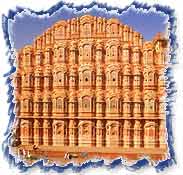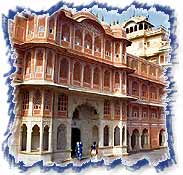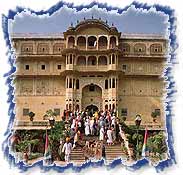The Rose Pink City founded by Maharaja Jai Singh II (1693-1743), is the
capital of Rajasthan. It is a major attraction for the first-time visitor.
Jaipur is surrounded on all sides by rugged hills, crowned with forts &
enclosed by embattled walls. Houses with latticed windows line the streets
with their rose pink colour, lending enchantment to the scene, which is
almost magical at sunset.
The Old City (Known as the Pink City) is a great place to wander around.
The whole city was painted in Pink colour by Maharaja Man Singh II when
Prince of Wales, later Edward VII, visited Jaipur in 1876 AD. Today, every
home within the city is obliged by law to maintain its facade. It is a very
well planned city laid out in a grid pattern and was designed by a young
Bengali engineer and scholar by the name "Vidyadhar Bhattacharya".
Jaipur was and remains the only city in the world, symbolising the nine
divisions of the universe, through nine rectangular sectors sub-dividing it.
Jaipur is a royal city & this is its most noticeable aspect, small
buildings & festivals testify it.
Jaipur & its surroundings are rather like an endless museum. The city
also offers an endless variety of crafts. Jewellers here still fashion the
beautiful enamel-on-gold pendants, studded on the reverse with precious
stones or pearls & turquoise that one sees in miniature paintings.
Jaipur's lacquer bangles are famous all over the world. This is a city to be
visited.
Rajasthan Train Travel :

Palace
on wheels : Ever wondered what luxury in the royal times was all about!
Welcome to Palace On Wheels, a luxury train that carries with it an ambience
of the Rajputana era and an exciting fairytale journey, which takes the
visitor to the imperial cities of Rajasthan every single day. The coaches
also carry out an image of the Rajput states with beautiful interiors. Last
but not the least the "Royal Treat" for the passengers on board
include saloons, bar lounges & libraries in every coach as well as
restaurant and organized shopping facilites.
Prime Attractions :
» Amer Palace - The magnificent fort with its huge
ramparts & watchtowers, overlooking the Delhi-Jaipur Highway. It is
believed to have been the capital of the "Minas", the original
inhabitants of Rajasthan.
» City
Palace- Nakkarkhana-ka-Darwaza, the imposing gateway of the City
Palace guarded by stone elephants, is monumental.
» Hawa
Mahal- A Pandora's box of wonders, the enchanting Hawa Mahal is a
multi-layered palace, with a profusion of windows and stone screens.
» Jai Garh - Built on a peak, Jai Garh
overlooks the palace & city of Amber below. Jal Mahal is Jaipur's lake
palace. It is surrounded with water.
» Nahargarh Fort - Originally called Sudarshan Garh,
it affords a splendid view of Jaipur.
» Jantar Mantar - The amazing astronomical
three-storey-high observatory, of an 18th century Rajasthani king, named Jai
Singh.
 » Sisodia Rani Ka Bagh -
» Sisodia Rani Ka Bagh - Has beautiful gardens,
fountains, pools & some magnificent pieces of sculpture.
» Vidyadhar's Garden - Nestled in a narrow valley,
this beautiful garden was built in honour of Jai Singh's chief architect and
town planner.
» Government Central Museum - This is the oldest
museum in the state. The buiding, designed by Colonel Sir Swinton Jacob is
located in the centre of the sprawling Ram Niwas Bagh, built in 1876 AD.
When King Edward VII visited India as the Prince of Wales, it was opened to
public in 1886.
» Bairath (86-km on
the Shahpura-Alwar Road) - An important historical place with the
excavated remains of a circular Buddhist temple - unique in Rajasthan and
the earliest known temple in India. Bairath also has relics of the Mauryan,
Mughal and Rajput periods. A mint constructed by Akbar, a beautiful Mughal
garden and a remarkable monument with painted 'chhatris' and wall built by
Jahangir, are other attractions.
» Galta (2.5-km) - Beyond the gardens amidst the low
hill guarding the city lies the old pilgrim centre of Galtaji. Temples,
pavilions and holy 'kunds' (natural springs and reservoirs) dot the serene
green landscape. The small temple of the Sun god, built by Diwan Kriparam on
top of the highest peak, is visible form all parts of the city.
» Ramgarh Lake (32-km north-east) - Ramgarh
Lake (32-km north-east): A huge artificial lake created by constructing a
high dam amidst tree covered hills. While the temple of Jamwa Mata and the
ruins of the old fort are some of its antiquities, its beautiful landscape
makes it an idyllic picnic spot.
» Samode (40-km north-west) - The beautiful Samode
Palace, has been rebuilt and renovated and provides a fine example of the
Rajput haveli architecture. It is an ideal spot for outings.
Cities :
 »
Sanganer (16-km) -
»
Sanganer (16-km) - Located on the Tonk Road. This small town is entered
through the ruins of two 'Tripolias' or triple-gateways. The town has a
ruined palace and a group of Jain temples with fine carvings. Entry to the
temples is restricted. The town is an important centre for craft, industry
and produces some of the finest hand printed textiles from units of block
and screen printers. This textile is popular all over the country and
abroad. On the Ajmer Road, the ground level fort is still in good shape. It
is noted for its hand printed handloom industry using simple techniques.
» Gaitor (6.5-km on the road to Amer) - There are
memorials to the queens in the Maharani-ki-Chhatri complex near the Ramgarh
road crossing. The white marble cenotaph of Maharajah Jai Singh II is the
most impressive and is decorated with carved peacocks. Next to it is the
cenotaph of his son. The island palace-Jal Mahal built by Sawai Madho Singh
as a pleasure spot at the centre of the Man Sagar Lake, and the Kanak
Vrindavan complex of temples and gardens recently renovated add to its
pristine glory.
To the west of this road, in a narrow valley, is the royal cremation ground
at Gaitor. The cenotaphs of all Jaipur rulers, with the exception of Sawai
Ishwari Singh, who was cremated outside the Jai Niwas Garden, were built at
this place. The imposing cenotaph of Sawai Jai Singh stands out for its
delicate carvings and beautiful shape.


 Palace
on wheels : Ever wondered what luxury in the royal times was all about!
Welcome to Palace On Wheels, a luxury train that carries with it an ambience
of the Rajputana era and an exciting fairytale journey, which takes the
visitor to the imperial cities of Rajasthan every single day. The coaches
also carry out an image of the Rajput states with beautiful interiors. Last
but not the least the "Royal Treat" for the passengers on board
include saloons, bar lounges & libraries in every coach as well as
restaurant and organized shopping facilites.
Palace
on wheels : Ever wondered what luxury in the royal times was all about!
Welcome to Palace On Wheels, a luxury train that carries with it an ambience
of the Rajputana era and an exciting fairytale journey, which takes the
visitor to the imperial cities of Rajasthan every single day. The coaches
also carry out an image of the Rajput states with beautiful interiors. Last
but not the least the "Royal Treat" for the passengers on board
include saloons, bar lounges & libraries in every coach as well as
restaurant and organized shopping facilites. 
 »
Sanganer (16-km) - Located on the Tonk Road. This small town is entered
through the ruins of two 'Tripolias' or triple-gateways. The town has a
ruined palace and a group of Jain temples with fine carvings. Entry to the
temples is restricted. The town is an important centre for craft, industry
and produces some of the finest hand printed textiles from units of block
and screen printers. This textile is popular all over the country and
abroad. On the Ajmer Road, the ground level fort is still in good shape. It
is noted for its hand printed handloom industry using simple techniques.
»
Sanganer (16-km) - Located on the Tonk Road. This small town is entered
through the ruins of two 'Tripolias' or triple-gateways. The town has a
ruined palace and a group of Jain temples with fine carvings. Entry to the
temples is restricted. The town is an important centre for craft, industry
and produces some of the finest hand printed textiles from units of block
and screen printers. This textile is popular all over the country and
abroad. On the Ajmer Road, the ground level fort is still in good shape. It
is noted for its hand printed handloom industry using simple techniques. 